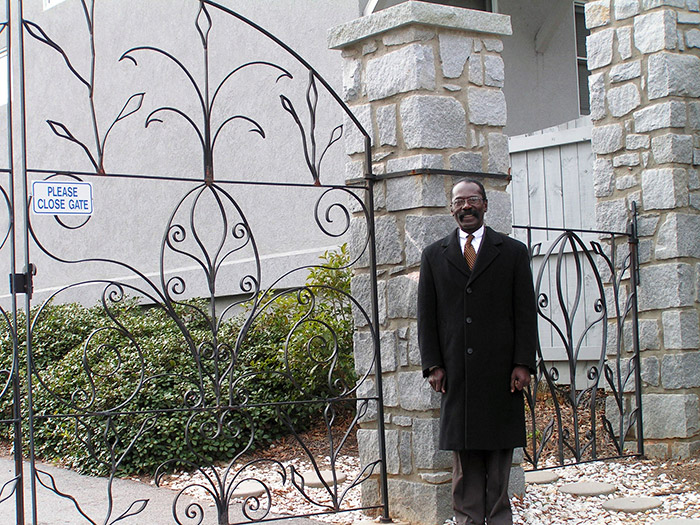
Hand-made ornamental gate by craftsman, Phillip Simmons
Columbia Historic Sites
The Big Apple
DESCRIPTION: A former synagogue and nightclub, the Big Apple has been a Columbia landmark for the past 100 years. It was built as the House of Peace synagogue around 1907 and originally located at 1318 Park Street. In the late 1930s, the nightclub spurred the Big Apple dance craze that captured the nation. It became one of Columbia’s most popular African American dance spots at a time when South Carolina businesses were still segregated. Historic Columbia Foundation bought the property in 1993 and now rents the building out for a variety of social events.
ADDRESS: 1000 Hampton Street, Columbia, SC MAP
PHONE: 803-252-7742
Arsenal Hill
DESCRIPTION: One of the highest parts of the city, the area took its name from the Palmetto Armory munitions manufacturing facility located here before the Civil War. It became a prominent neighborhood for African Americans, including State Senator William Beverly Nash (1822–1888) and photographer Richard Samuel Roberts (1880–1936).
ADDRESS: bounded by Elmwood Avenue, Gadsden, Taylor and Assembly Streets, Columbia, SC MAP
Booker T. Washington High School
DESCRIPTION: Circa 1916, opened as the second public school for African Americans, this building came alive as a cultural and social center for the community it served. The property is now part of the University of South Carolina campus.
ADDRESS: Bull, Wheat, Marion and Blossom Streets, Columbia, SC MAP
Frederick House
DESCRIPTION: Nathaniel Jerome Frederick lived in this house, right around the corner from his law office in the North Carolina Mutual Building. After being admitted to the bar in 1913, he was the only practicing African American attorney in Columbia for many years.
ADDRESS: 1416 Park Street, Columbia, SC MAP
Good Samaritan-Waverly Hospital
DESCRIPTION: The Black hospital during segregation, afterwards it merged with Good Samaritan Hospital, a nurses’ training school; an unusually large number of Black doctors and nurses worked at or trained in the facility and resided in the Waverly neighborhood.
ADDRESS: 2204 Hampton Street, Columbia, SC MAP
Mann-Simons Cottage
DESCRIPTION: See evidence that all our Southern kin folks weren’t poor and enslaved before the Civil War. This cottage was built in 1855. Portraits of the Simons family and their artifacts from professions and religious affiliations are on display. The matriarch, Celia Mann, who was a free person of color, arrived in Columbia in 1850; the home includes an 1895 rosewood parlor suite that reflects the family’s significant financial success and status. Now home to the Historic Columbia Foundation.
ADDRESS: 1403 Richland Street, Columbia, SC MAP
PHONE: 803-252-1770
WEBSITE: http://www.historiccolumbia.org/history/mann_simons.html
Modjeska Monteith Simpkins House
DESCRIPTION: From 1931 until her death in 1992, Modjeska Monteith Simpkins constantly made significant contributions to African American public health reform as well as to the national Civil Rights Movement. For years, her home served as a meeting place for dignitaries. Guests included Supreme Court Justice, Thurgood Marshall, who litigated Briggs vs. Eliot case in 1954, which became a constituent part of the landmark Supreme Court case, Brown vs. Topeka Board of Education.
ADDRESS: 2025 Marion Street, Columbia, SC MAP
PHONE: 803-748-8644
North Carolina Mutual Building
DESCRIPTION: Circa 1909, the North Carolina Mutual and Provident Association Building was the first law office for Nathaniel Jerome Frederick, who was an educator, principal of Howard School in Columbia, editor and political leader. Housed many Black professionals and businesses. Built by the North Carolina Mutual and Provident Association headquartered in Durham.
ADDRESS: Washington Street at Park Street, Columbia, SC MAP
Randolph Cemetery
DESCRIPTION: Founded by 19 African Americans in 1871, the cemetery is a memorial to Benjamin A. Randolph, a member of the Reconstruction General Assembly, who was assassinated in Abbeville in 1868. Randolph and eight other African American Reconstruction legislators are buried here.
ADDRESS: 1538 Sumter Street, Columbia, SC MAP
South Carolina Community Bank
DESCRIPTION: Founded by Dr. H.D. Monteith and members of his family in 1921 as Victory Savings Bank. In 1999, the bank expanded its mission and was renamed Victory State Bank. Today, the bank is the state’s only minority-owned banking institution.
ADDRESS: 1545 Sumter Street, Columbia, SC MAP
PHONE: 803-696-5577
WEBSITE: http://www.sccommunitybank.net
Richard Samuel Roberts House
DESCRIPTION: Roberts was a self-taught photographer. By 1922 he had opened a photography studio in the heart of Columbia’s Black business district. His photographs are important documents recording the rise of the Black middle class in Columbia during the 1920’s and 1930’s. Not open to the public.
ADDRESS: 1717 Wayne Street, Columbia, SC MAP
Columbia NAACP
ADDRESS: 1114 Blanding Street, Columbia, SC MAP
PHONE: 803-256-8771
WEBSITE: http://www.scnaacp.org
Columbia Urban League
ADDRESS: 1400 Bardwell Street, Columbia, SC MAP
PHONE: 803-799-8150
WEBSITE: http://www.columbiaurbanleague.org
Black News
DESCRIPTION: Newspaper for and about Black Columbians
ADDRESS: 1310 Harden Street, Columbia, SC MAP
PHONE: 803-799-5252
WEBSITE: http://www.scblacknews.com
Imara Woman
DESCRIPTION: This magazine & website for African American women started in 2001
ADDRESS: 2731 River Drive, Columbia, SC MAP
PHONE: 803-252-0647
WEBSITE: http://www.imarawoman.com
Lutheran Theological Southern Seminary
DESCRIPTION: See wrought iron gates crafted by Councilman Sam Davis, an apprentice of legendary Ironmaster Philip Simmons of Charleston.
ADDRESS: 4201 North Main Street, Columbia, SC MAP
PHONE: 803-786-5150
Millwood Plantation Ruins
DESCRIPTION: Once a grand plantation mansion on 13,000 acres, it belonged to Confederate General Wade Hampton III. You can image the number of enslaved people required to work the land and upkeep the huge mansion. During Union General Sherman’s occupation of Columbia in February 1865, the home was burned to the ground in the Civil War. guided tours provided March-October on the last Sunday of the month.
ADDRESS: 6100 Garner’s Ferry Road, Columbia, SC MAP
PHONE: 803-252-1770
